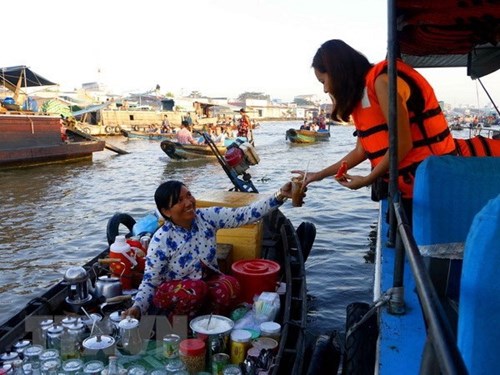The western region of the Mekong Delta comprises Can Tho City and the six provinces of Bac Lieu, Ca Mau, Soc Trang, An Giang, Hau Giang and Kien Giang.
In the first six months of the year, the number of tourist arrivals to the region rose by 11 percent to reach 17.8 million, accounting for more than 76 percent of total tourist arrivals to the Mekong Delta region.
Tourism revenue was estimated at VND 10.4 trillion (USD 452.1 million), a year-on-year increase of more than 33 percent.
Tran Hieu Hung, Director of Ca Mau province’s Department of Culture, Sports and Tourism, said the tourism cooperation program in the western cluster failed to bring expected outcomes due to an overlap in tourism products and uninteresting inter-regional tour packages.
    |
 |
|
Visitors at Cai Rang floating market in Can Tho City. |
Under the program, the seven localities pledge to cooperate in marketing and promotion activities, new tourism products, unique inter-regional tour packages, human resource training, and international and national tourism events.
But the tourism potential in these localities has yet to be fully realized due to loose regional linkages in development of new tourism products and an overlap in tourism products, poor infrastructure and services, as well as ineffective and insufficient marketing.
Bui Quoc Thai, Deputy Director of Kien Giang province’s Department of Tourism, said localities in the Mekong Delta region were seeking unique tourism products.
The Mekong Delta region is well known for its waterway landscape, rice paddy fields, and verdant orchards, but localities do not invest in innovative and attractive models, resulting in similar tourism products, Thai said.
Floating markets, Don ca tai tu (southern amateur music) and food, for example, are designed for all kinds of tours. As a result, travelers just visit one place in the region.
Pham The Trieu, Deputy Director of An Giang province’s Department of Culture, Sports and Tourism, said tourism human resources lacked skills in communication, foreign languages, and professional and management skills.
Although tourism infrastructure and lodging facilities in the region have developed rapidly to meet the rising demand, most are small scale, Trieu said.
There is also a lack of high-end facilities and services operated by famous brands, he said.
Tourism experts said the linkages in tourism products aim to give diverse experiences and attractive itineraries to tourists.
Du To Tuan, Director of Vietravel’s Bac Lieu province branch, said that localities should take into consideration the demand of different age groups and incomes as well as specific market segments such as local and inbound tourists to develop tourism products and marketing strategies.
Tourism products for inbound visitors should focus on ecotourism tours, cultural and craft villages, local lifestyles and festivals.
Spiritual tourism is mostly favored by local tourists, he said.
Cao Tan Dung, Deputy Director of Fiditour’s Can Tho city branch, said a tourism product should be well organized to satisfy demands during the entire trip, from restaurants, accommodations to destinations.
Can Tho city and Phu Quoc island in Kien Giang province, as the region’s tourism hubs, should play a driving force for the tourism industry of the entire region, Dung said.
Under the master plan for tourism development in the Mekong River Delta region, the western cluster in the Mekong Delta will focus on unique tourism products such as the Ca Mau Cape, sea and island leisure tourism, eco-tourism, and cultural tourism.
The plan targets developing three destinations in the cluster, including Phu Quoc island in Kien Giang province, Ca Mau Cape tourism area in the country’s southernmost province of Ca Mau, and Sam Mountain in An Giang province.
It also focuses on the development of four national tourist sites, including Ong Ho islet in An Giang province, Don ca tai tu and musician Cao Van Lau memorial house in Bac Lieu province, Ninh Kieu wharf in Can Tho city and Ha Tien town in Kien Giang province.
Source: VNA